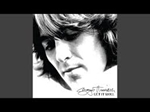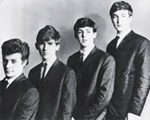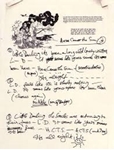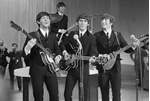- Register
- Log in to Tune-In
- Wishlist (0)
-
Shopping cart
(0)
You have no items in your shopping cart.
Beatles News

Sir Paul McCartney has said he sometimes picks up his grandchildren from school, and that it is a “joy”.
The former Beatles star said that he is “pretty normal” when it comes to his relationship with his eight grandchildren despite his fame, and that they often go on holiday together.
Sir Paul, 77, told Chris Evans on his Virgin Radio Breakfast Show that he is a “terrific” grandparent, adding: “You know, I love them and I love being a granddad.
“And we spend quite a good bit of time together. We don’t live near each other, but we go on holiday together, like Christmas. And in the summer we’ll see each other. And then sometimes me and (my wife) Nancy pick them up from school. So that’s nice.”
He said: “It’s great fun you know, because you don’t know how to do it like parenting. It’s ad lib, it’s the biggest ad lib. So when grand-parenthood comes around, it’s like, ‘OK, what do we do here?’ And so I say that joy is like picking them up at school and they love it.”
He added: “I don’t think it’s just us, I think it’s also the ice cream that&rsqu details

November 29, 2001 would be remembered forever in the music rock history. On this day 18 years ago, this legend passed away from lung cancer at age of 58.
As a 15-year old boy from Liverpool, Harrison became a member of the Quarrymen (who would later become The Beatles), despite John Lennon thinking that he was too young. Having to compete with the power-writing duo that was Lennon and Paul McCartney, George was able to slip a song or two of his own onto almost every Beatles album during the group’s existence.
Some of the songs included “Taxman” (1966’s Revolver), “Within You Without You” (1967’s Sgt. Papper’s Lonely Hearts Club Band), “Here Comes the Sun” and “Something” (both from 1969’s Abbey Road) and many more.
Even more impressive may have been his solo work, as the period following The Beatles proved Harrison to be a truly great singer-songwriter in his own right, now being out of the shadow of his former band mates. 1968 would see him be the first Beatle to release a solo record, with Wonderwall

Paul McCartney reacts to George Harrison’s death in 2001
Between 1963 and 1970, The Beatles released 12 studio albums. But have you ever wondered which one was the favourite of John Lennon, Paul McCartney, George Harrison and Ringo Starr? Well, at different points in their lives the Fab Four revealed their individual personal picks of the dozen.
Ringo Starr – Abbey Road (1969)
Probably The Beatles album with the most famous cover, Abbey Road celebrated its 50th anniversary this year.
The band’s penultimate record was a favourite for Ringo, who especially liked the much-maligned Abbey Road Medley.
Ringo told Rock Cellar Magazine a couple of years ago: “For me, that would be the second side of Abbey Road.
“That one is my favourite because I just love all those bits and pieces that weren’t full songs that John and Paul had been working on and pulled all together — Mean Mr. Mustard, Polythene Pam, and She Came in Through the Bathroom Window.”
Source: George Simpson/express.co.uk

It will be 18 years at the end of this month since “quiet Beatle” George Harrison passed away of throat cancer in 2001. His music lives on with his timeless melodies on songs such as Something, Here Comes the Sun, and I Got My Mind Set On You.
After George and his first wife, Pattie Boyd, separated in 1974 and then divorced three years later, he met and married Olivia Arias in 1978.
Olivia was a secretary when she met George. Born in Los Angeles, Olivia Trinidad Arias saw the Beatles in concert two times, once at the Hollywood Bowl on August 29, 1965, and then a year later at Dodger Stadium on August 28, 1966.
In 1973, she started working at A&M Records, which by the following year won the rights to distribute George Harrison’s Dark Horse solo records globally.
In the midst of the negotiation process, George and Olivia chatted by phone frequently. Eventually, the former Beatle wanted to know more about his phone friend and asked his friends to get more information about her for him.
Source: cheatsheet.com

George Harrison, Paul McCartney and John Lennon tried out mop-top haircuts while in Hamburg. It would become the Beatles' signature look. Original drummer Pete Best, left, stuck with his Liverpool ducktail cut. (The Plain Dealer)
You can make the Beatles fan in your life very happy this holiday season -- if you’re feeling particularly generous. And if your Beatlemaniac potential giftee doesn’t put Ringo first among the Fab Four.
Heritage Auctions is offering up a postcard signed by the Beatles when the Liverpudlians were resident rockers in the German city of Hamburg, a couple of years before they hit it big.
They were already big enough in Hamburg, however, that they had their own band-specific postcard offering the group’s “best wishes” on April 5, 1962. Heritage Auctions’ “buy now” price for the collectible: $12,500. The auction is open until Dec. 2.
Source: oregonlive.com
details
The official Twitter account for the Beatles tweeted out the following Ringo Starr quote. The quote actually comes from an old media interview that he gave. The quote expands on the reasoning for why The Beatles broke up and gives us a small glimpse into the making of that decision. Paul McCartney wife reveals ‘miserable’ Ringo Starr photo.
The quote stated:”(None) of the decisions were made quickly. We’d all expressed them & moaned about them, laughed about them & cried about them. Then it had got to a head where it was ‘yes’ or ‘no’ time – and we seemed to do that with the touring, with the recording & with the breaking-up.”
In other news regarding The Beatles, fans took to social media to reflect on Ringo Starr’s most recent studio release – ‘What’s My Name.’ One reviewer wrote: “This latest offering by Ringo literally flew under my radar if it were not for a tip-off from an old pal that Ringo was covering Lennon’s unreleased “Grow Old With Me” in collaborative fashion with McCartney’s inclusion.
Source: Mike Mazzarone/alternativenation.net

By the late 1960s, George Harrison had come to a realization: He could match the songwriting efforts of John Lennon and Paul McCartney. Beatles fans probably started to see that around the days of Revolver (1966). By the time Abbey Road (1969) went out, there was no denying it.
“I could see everybody’s a Lennon/McCartney if that’s what you wanna be,” George said in early 1970. “But the point is nobody’s special. If Lennon/McCartney are special, then Harrison and Starkey are special, too. What I’m saying is that I can be Lennon/McCartney too.”
With “Something” and “Here Comes the Sun,” George no longer needed to prove his case. And indeed he’d learned some tricks from John and Paul. One such trick was starting with someone else’s line to get a song’s lyrics going.
Just as John had done with an Elvis Presley line on “Run For Your Life,” so George did with a James Taylor line at the start of “Something.” And he also ran with one of John’s lyrics to start “Here Comes the Sun.”
Source: cheatsheet.com

“Let It Be Christmas” returns to Naperville’s Community Christian Church with nine performances in December. The rock opera tells the story of Jesus’ birth through the music of The Beatles. (Jennifer Pedley)
For 12 years, a Naperville church has presented the story of Christmas set to the songs of The Beatles. The result is “Let It Be Christmas (The Gospel According to Matthew, Mark, Luke, John, Paul, George and Ringo).”
“Let It Be Christmas” returns with nine performances at Community Christian Church in Naperville, presented by Epic Theatre Company. Shows are at 7:30 p.m. Dec. 6-7, Dec. 13-14 and Dec. 20 and 3 p.m. Dec. 7, Dec. 14 and Dec. 21; and 11 a.m. Dec. 21.
The cast consists of 80 local children and adults. Epic is associated with the church.
“It’s grown quite a bit. It’s been quite the evolution,” said Elic Bramlett, director of “Let It Be Christmas.”
How did they come up with the idea?
“Well, like all good ideas, we stole it from someone,” he laughed. “It helps that it is a good friend that we stole it from.”
Source: Annie Alleman/chicagotribune.com< details

When we look back at The Beatles’ career, it’s only natural that we trace their progress through the groundbreaking albums they made between 1963 and 1969. But that only tells part of the story. The Beatles may have helped shift the focus from singles to long-playing albums, but at the start of their career they were, first and foremost, a band that made phenomenal singles, many of which didn’t actually appear on their albums. With pop music still primarily a singles market in the mid-60s, The Beatles’ singles, then, offer something of a parallel discography: a different lens through which to trace their artistic trajectory.
1962: ‘Love Me Do’
The group had actually recorded a single even before signing with Parlophone. Credited as The Beat Brothers, John, Paul, George and Pete Best backed the English singer Tony Sheridan on a rocked-up version of ‘My Bonnie Lies Over The Ocean’, which was released on Polydor in West Germany. It was a customer’s request for that recording that led to Liverpool record-shop owner Brian Epstein tracking down and eventually managing The Beatles.
Source: udiscovermusic.com

Ringo Starr is regarded as talentless by some fans of the Beatles. Others simply feel he didn’t have as much talent as the other three members of the band. Many Beatles fans might be surprised to know that Ringo did not play the drums on the group’s first hit, “Love Me Do.” Here’s why.
Despite what others have said about Ringo, the other Beatles were in awe of his talent. According to The Spectator, Paul McCartney has positive memories of the first time he saw Ringo drumming.
“This was, like, a grown-up musician. I remember the moment, standing there and looking at John and then looking at George, and the look on our faces was like …what is this?” he said. “And that was the moment, that was the beginning, really, of the Beatles.”
Although Paul said the Beatles weren’t really the Beatles until Ringo joined the band, the group’s producer, George Martin, felt differently. He didn’t like the sound Ringo brought the band’s recordings.
Source: cheatsheet.com
details
Next month marks the 39th anniversary of John Lennon’s death at the hands of gunman Mark David Chapman outside the historic Dakota apartment building in New York City. Lennon fans will be eager to watch Killing John Lennon, “a dramatic psychoanalysis and step-by-step breakdown of the lead-up to one of the most infamous assassinations in history,” said Thomas Gould, Flame’s VP, Content Sales, Worldwide Transport. “The one-hour biographical documentary also explores the life of John Lennon leading up to his murder, when he broke up with The Beatles to pursue a solo career … and as a political activist alongside his wife Yoko Ono in New York city.”
Food, art and design buffs will surely appreciate Flame’s new eight-part series, A Long Weekend in…With Rory O’Connell. A world-renowned chef and food writer, O’Connell takes viewers on a whirlwind tour of art, culture, architecture during his culinary adventures in cities like Copenhagen, Vienna and Lisbon.
Source: apex.aero
details
Elton John has opened up about how former Beatles guitarist George Harrison helped him during his long battle with drug addiction.
Speaking to Chris Evans on his Virgin Radio Breakfast show, the 72-year-old recalled how Harrison helped him when he was at the peak of his addiction. something he discussed in his recent memoir ‘Me’. The book sees Elton recalling the time he hijacked a Rolling Stones show while high on cocaine, as well as the moment when he mistook Bob Dylan for his gardener while high – describing him as “scruffy”.
Evans asked Elton what the “best piece of advice” was that Harrison gave him. “Stop putting that marching powder up your nose,” John laughed, before celebrating his 29 year sobriety with Evans. “Twenty-nine-years it’s been. The nose is still here!”
Elton also went on to give some advice to young musicians starting out now on the show. “You’ve got to play live…If you want to have a career, record sales will go up and down and people are so fickle,” Elton advised. He continued: “Now, when you’re young, they’ll drop you like a five-pound note on the floor and you’ details

The Beatles legend, Paul McCartney recently spoke to Billboard about a bunch of issues. Here, the iconic co-founder of the ‘Fab Four’ discussed the purchase of the current holding company, MPL, which McCartney bought back in the late sixties was an answer to not owning his own body of work with the Beatles. In addition, McCartney discusses how much equity he was given for his company, along with John Lennon. Paul McCartney just revealed what he ‘stole’ from Bono.
I think so. John and I felt screwed out of our rightful recompense. With our original agreement with Dick James, Dick went to us and said, “You can have your own company.” And we were young boys — we were young and foolish, but we were beautiful! And we said, “Wow, great.” So he gave us our own company, Northern Songs, which was 49% us, 51% him, which gave him voting control. Later, we went to him a couple of times and said, “Dick, now that we’ve done all this stuff, can we have a raise?” And he basically said, “I’m sorry, I can’t — you’re under contract.” I now know he could’ve just said, “I’ll give you a new contract.” So when I details

If you live in Arkansas, you know about Central High School, you know about the Little Rock Nine, and you know what happened in September of 1957.
But what you may not know – is the impact that moment had around the world.
"I think many Arkansans don't realize just how wide an impact the school crisis made. It was international headlines in every country around the world and reverberated across the globe," said Dr. John Kirk, a Professor of History at U-A Little Rock.
Kirk's an expert on the civil rights movement, with a focus on Little Rock's place in it. But, he's not the only person from the United Kingdom with an interest in Arkansas history.
In 2016, Sir Paul McCartney took the stage at Verizon Arena and shared his connection with our state's past. He told the crowd that the civil rights struggle in the U.S, specifically the Little Rock Nine, inspired one of the Beatles' biggest hits.
Source: JD Roberts, Ashley King/thv11.com
details
When The Beatles were in the studio, Paul McCartney was most often the one driving everyone nuts during the recording process. That was certainly the case with “Maxwell’s Silver Hammer,” the Abbey Road track the other Beatles came to despise.
Paul’s obsession with getting a recording just right was the thing that got under his bandmates’ skin. During the White Album sessions, his endless tweaking of “Ob-La-Di, Ob-La-Da” annoyed everyone involved — even the typically unflappable George Martin.
By most accounts, John Lennon had a different approach in the studio. John could be downright impatient when it came to recording his songs. In one case, he was willing to accept a Ringo drum part he disliked simply to move the process along. (Ringo later fixed it on his own.)
But John claimed the band (led by Paul) took a different tack when recording his tunes. He described an “atmosphere of casualness” he never noticed while recording Paul’s songs. And he said Paul “subconsciously tried to destroy” some of his greatest work.
Source: cheatsheet.com
